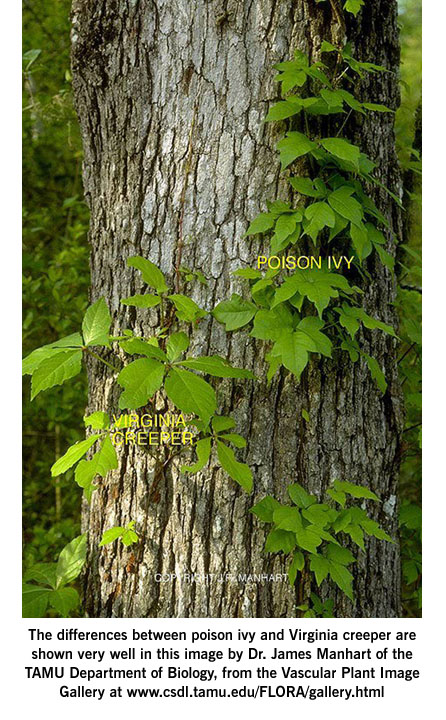
Poison Ivy Control in the Landscape
Poison ivy (Rhus toxicodendron) is a common problem in Parker County. While it is most prevalent in rural areas, it can also become a nuisance in urban and suburban landscapes. The vine develops roots readily when in contact with the ground or with any object that will support it. Larger vines may look like a fuzzy rope.
Poison ivy is most easily identified by its leaves. Leaf forms vary among plants, or even on the same plant. However, the leaves almost always consist of three leaflets. A saying to remember to help identify poison ivy is “A Leaflets three, let it be”. Only one three-part leaf leads off from each node on the vine. Leaves never occur in pairs along the stem. Poison ivy resembles and sometime grows along side Virginia creeper, which has 5 leaves and is not poisonous. [See image
Flowers (white or cream colored) and fruit are always in clusters on slender stems that originate in the axils between the leaves and woody twigs. Berry like fruits usually have a white, waxy appearance and are sometimes hairy in appearance.
The skin irritant of poison ivy is a non-volatile phenolic substance called urushiol which is found in all parts of the plant. A very small amount of the poisonous substance can cause severe inflammation of the skin. The poison can also be transferred on clothing and pets over a prolonged period of time. Smoke from burning plants carries the toxin and can cause severe injury when inhaled.
Individuals vary in their sensitivity to poison ivy. Mild cases of inflammation usually subside within a few days. If the inflammation is severe or extensive, consult a physician.
To reduce the incidence of inflammation from poison ivy a person should:
- Be aware of surroundings and be able to spot poison ivy plants.
- Destroy poison ivy plants in landscape areas.
- Avoid contact with pets that might have contacted poison ivy.
- Wash contaminated skin with soap and water immediately.
Poison ivy may be controlled in a variety of ways. Grubbing is quite effective if only a few plants are involved and the soil is adequately moist. Poison ivy vines climbing on trees should be severed at the base. Bury, bag or destroy roots and stems because the dry material also contains the skin irritant. Mowing and plowing are of little benefit.
Herbicides are effective when applied properly. Spraying or wicking are two ways to efficiently apply chemicals. Products containing glyphosate (Roundup, Green Light Com-Pleet, Ortho Kleenup) or 2,4-D amine (Ortho Weed-B-Gon, Green Light Wipe Out) and triclopyr (Ortho Poison Ivy Killer, Ortho Brush B-Gon, Green Light Cut Vine & Stump Killer) provide control but must be used according to label restrictions.
These products should be carefully applied to the plants and leaves to provide control. They must be used with utmost care as they can drift onto other desirable plants or wash down into the desirable plants root system, causing significant damage. Cutting a poison ivy stem and painting the cut end immediately with one of these products may also be an effective way to kill the plant without harming adjacent plants or causing needless environmental damage.
Texas A&M AgriLife Extension Service
